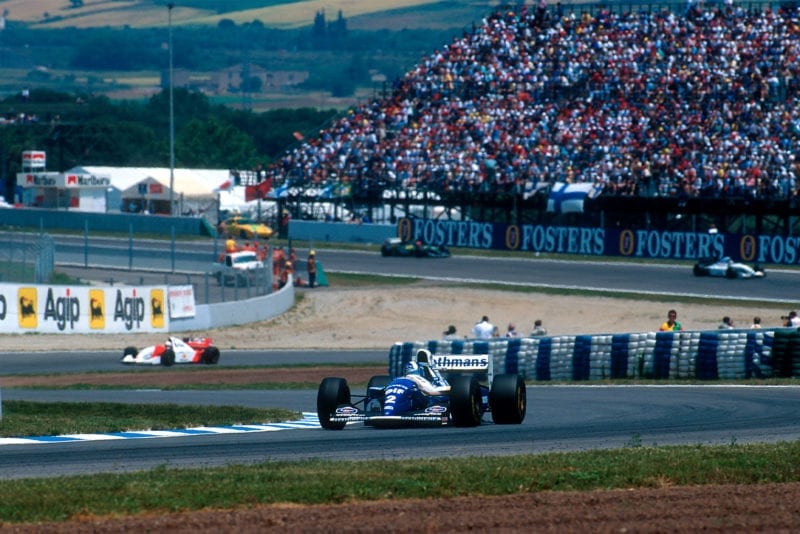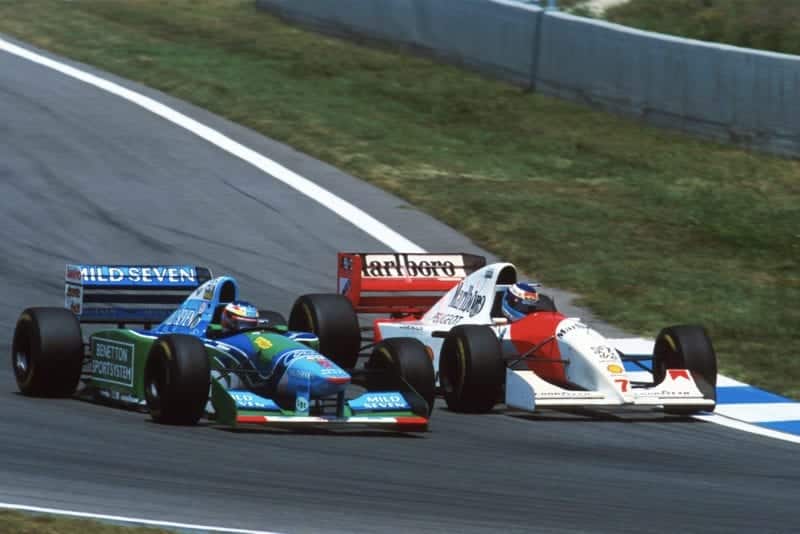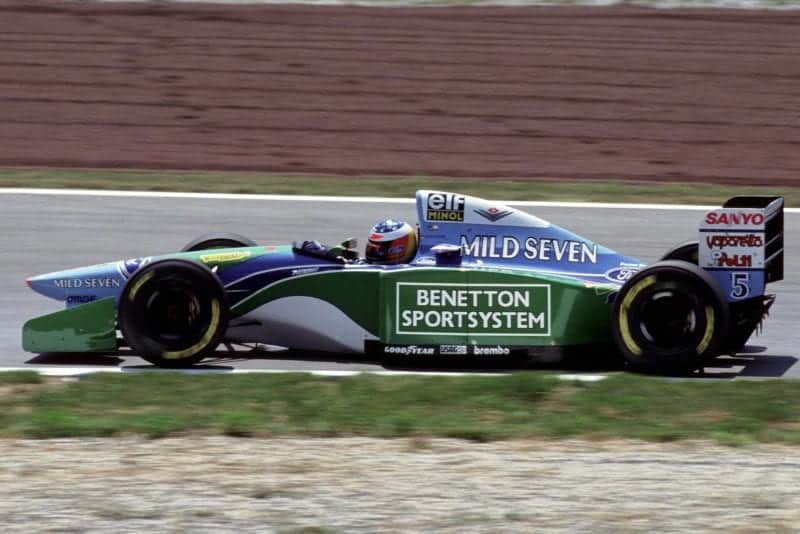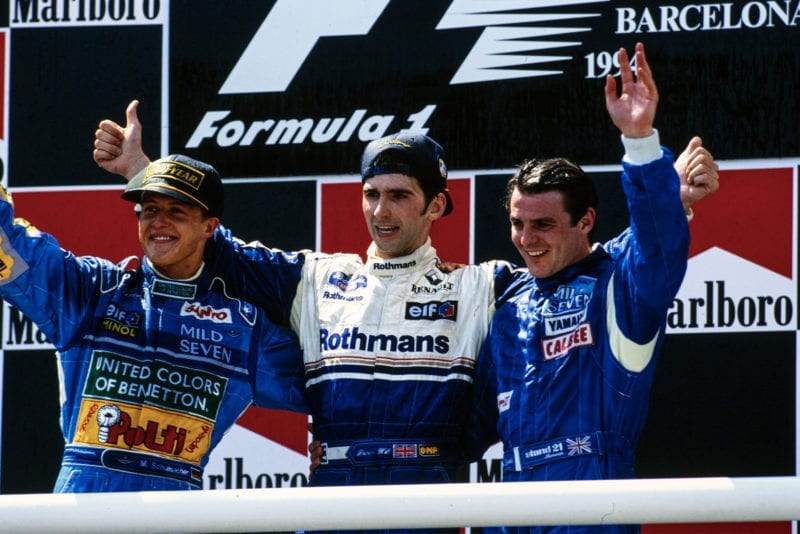A timely triumph
When Michael Schumacher’s Benetton stuck in fifth gear, Damon Hill was there to scoop the spoils for an intensely relieved Williams team.
There were many, it must be said, whose scepticism got the better of them after the Spanish GP. Could Michael Schumacher really have done the last two-thirds of the race in only fifth gear, including a pit stop?
You can try to calculate what percentage there could possibly have been for Benetton to lie about the problem (bar the obvious wish to detract from something else that was really wrong), but there would seem to be little point in making such a claim were in not true, and certainly the on-screen telemetry readings as we rode onboard with Schumacher indicated precisely that he was indeed mono-geared. McLaren actually ran a simulation on its computer programme after the race, and came up with the same answer: it was possible, and if you adjusted your style you could get by without losing more than a couple of seconds a lap. Which is exactly what the Heir Apparent did. He had a couple of very lurid slides around the 41 lap mark, perhaps on oil but possibly because he was still adjusting, but with or without first, second, third, fourth and sixth gears the German was coping brilliantly.

The start of the 1994 Spanish Grand Prix
Motorsport Images
“In the beginning I was doing lap times of 1 m 32s. I found a way to use fifth gear differently which meant I could do 1 m 26s again. It surprised me very much, but with my GpC experience I know a lot of ways of running differently, of saving fuel and changing my style of driving. It was this style of driving which helped me very much today. It got me out of the worst trouble.”
Benetton chief Flavio Briatore was all smiles afterwards. “This, for me, was Michael’s best ever race, even if he didn’t win. He was brilliant.”
And, indeed, he was all through another of those weekends when F1 seemed set to tear itself apart. It began with threats of a drivers’ boycott, because all bar one piece of the safety work they had asked for had been carried out. This, however, was the most important piece. The drivers were worried by the concrete wall on the exit to the Nissan corner, a quick right-left-right flick. “We come out of there at 240k,” said Martin Brundle, chairman of the newly reformed Grand Prix Drivers’ Association. “It could have been Tamburello all over again.”
They had asked for the section of track to be straight-lined, as the wall shielded a drop and could not therefore be removed. “The circuit organisers either didn’t want to, or had been told not to, make the change,” Brundle continued. “Maybe somebody wanted to see how much the drivers were going to stick together.”
They did, and for a while things looked doubtful.
“We said, ‘Okay, we don’t race'”, said Martin, and eventually nobody called their bluff, if indeed bluff it had been.

David Coulthard makes his F1 debut
Motorsport Images
A makeshift tyre chicane went up in time for Friday’s free practice session, but even then it was not quite plain sailing. This time it was Benetton, Williams, McLaren, Lotus, Jordan and Footwork on strike seeking an angry audience with Max Mosley to discuss the desirability or otherwise of the regulation requiring the cars to be run in modified guise that weekend, and the feasibility of the timescale he had imposed in Monaco for significant modifications to be made to the cars by Hockenheim. As Ferrari, Minardi, Sauber (with Heinz-Harald Frentzen only), Larrousse and Tyrrell went out that morning, Simtek and Pacific kicked their heels with the other big teams. “We’ve been advised it would not be in our best interests to go out,” said a member of one of the two new teams, “and in the circumstances we understood the message we were getting. . .”
Earlier in the week Flavio Briatore had written a critical, open letter to Mosley and circulated it to the national media, while Ron Dennis had been privately critical. The mood of the meeting in the Williams motorhome between Bernie Ecclestone (as President of FOCA), Briatore, Dennis, Frank Williams, Peter Collins, Eddie Jordan, Jackie Oliver, Nick Wirth and Keith Wiggins on the one side, and Mosley on the other, was far from cordial, despite what the various parties might have had you believe. “We had a frank and positive exchange of views,” said Frank Williams, but he had the grace to laugh when it was put to him that it might better be said that Mosley had a received a positive exchange of Frank’s views.
The real outcome of this little squabble is still moot (see Diary), as Mosley denied any climb down or any threat of boycott, but both Benetton and Lotus, to name but two teams, were prepared to sit it out as long as it took.
Whatever, it was business as usual in the afternoon, and despite his lack of experience running his Benetton in the new ‘Barcelona’ specification, with truncated diffusor and shallower front wing endplates, he comfortably dominated practice. Plus ca change, plus c’est la meme chose, as they say.
At last, as Hill joined the German on the front row in a Williams FW16 that reacted well to a less bumpy track surface, and Mika Hakkinen and JJ Lehto in the second Benetton lined up on the second, everything seemed well again on F1’s surface and it was momentarily possible to forget about the troubled undercurrents, but there had been another horrible shock at the end of free practice on Saturday morning when the Italian Andrea Montermini had crashed his Simtek exiting the final corner that leads on to the pit straight. He had got all four wheels off into the dirt and made the mistake of trying to fight the car too much, to the point where it suddenly found some grip and speared sharp left into the concrete wall that leads the run-off area back into the straight itself. The Simtek was thrown back on to the track where, minus its front wheels and with Montermini’s feet sticking out the open front end of the monocoque, it slewed to a halt right opposite the pits.
It was as if cruel gods were reminding the sport of just what they could do if they wished, and in places in the press room which overlooks the scene there was something uncomfortably close to hysteria as people looked down on the sight of a crumpled Simtek whose driver lay with his head at that horrible, still angle. It was unpleasantly reminiscent of Ratzenberger’s accident at Imola, the more so because Montermini was his replacement within the team. The whole thing was chilling, until word filtered through that he had had a miraculous deliverance and was nursing only minor injuries (see Diary). The collective sigh of relief could have been heard in Indianapolis.
By the time Schumacher blasted neatly and without wheelspin into the lead on Sunday afternoon most just wanted things to end, and there was further relief that the real business, the reason why everyone was in Spain in the first place, had finally arrived.

Michael Schumacher and Mika Hakkinen go wheel-to-wheel
Motorsport Images
And, in one of those quirks, it was actually a good race. True, Schumacher blew into the distance in the early going, so that by lap 21 when he made his first of two scheduled fuel and tyre stops he was more than 15s ahead of Hakkinen (who had temporarily got ahead of Hill during the stops). But then that fifth gear problem arose on the German’s car, and by lap 25 things were looking decidedly different as Hakkinen led from Hill, with Schumacher and Lehto at respectful distances. A little further back, Alesi had his hands full containing Brundle, the Ferrari set up for straightline speed and thus able just to stay in front, the McLaren all over it all round the circuit, but unable to squeeze by down that long, long pit straight.
So far this year strategies on fuel and tyre stops have tended to be far too similar to create much interest. Williams found out the hard way in Brazil that one stop makes Jack a dull race, but in Barcelona McLaren opted to run Hakkinen on a three-stop policy, so when the Finn came in again on lap 30 and surrendered an eight second lead over Hill, the Briton moved into the lead and Mika had to work all over again to catch and pass Schumacher.
The German actually got a respite when Damon stopped gain in lap 41, as he retook the lead against all expectations. But his own final stop was eagerly awaited and he duly came in on lap 45. How was he going to get out of the pits with only fifth gear?
Here he was fortunate, for the pit lane speed limit certainly worked to his advantage since everyone had to leave gently, and with a lot of revs and no small helping from the Ford Zetec-R’s beefy torque curve he managed to stagger back into the fray without even losing a place to Lehto.
Hakkinen, too, made his last stop on lap 45, losing a 14s advantage he had nursed over Hill and dropping back to third again, the position he had occupied in the opening stages. Now the battle was on, for the three leaders were now all set to run to the flag. By lap 48 Hill had a 7.5s lead over Hakkinen, who was 2.9s adrift of Schumacher but clearly on a charge. Sadly, however, that came to nothing when his Peugeot V10 let go in a significant way on the following lap.

Michael Schumacher’s Benetton
Motorsport Images
Whether Schumacher could do anything about Hill became another moot point as the race progressed, for though the gap had fluctuated a few tenths either side of those seven and a half seconds, the track was getting very slippery and in the end Schumacher elected to bank six points rather than push too hard for 10 and wind up with nothing. From lap 55 onwards the Spanish GP rather fizzled out.
Lehto’s strong run his best in his three outings so far for Benetton ended with engine failure on lap 54, which was a great shame. Destroyed by Schumacher’s speed in his own B194 at Monaco, where his neck also troubled him, JJ looked far more in the swing of things this weekend, and was actually fastest in the morning warm-up on race day.
Brundle, too, would be unlucky. He’d been stuck in eighth place behind Schumacher, Hill, Hakkinen, Alesi, Lehto, Coulthard and Barrichello in the early laps before steadily moving up the leader board, and a blend of good stops and sound driving had him up to fifth when Hakkinen expired. That became fourth with his team-mate’s demise and third when Lehto retired, but any hopes of a second consecutive podium finish for McLaren evaporated in a cloud of smoke and a sheet of flame as his car exploded going down to the first corner on his 60th lap. The transmission had blown up, according to the official source, but the cynics put more store in a second Peugeot breakage, such was the mechanical carnage at the back of the MP4/9.
Alesi should have taken third place, then, but the Ferrari looked a ponderous handful, and in contrast Mark Blundell’s well-driven Tyrrell-Yamaha was nimble and effective. The Briton, anxious to stem a tide of the misfortune that has struck him all year, was pushing very hard and after moving ahead of the red car when it stopped for fuel and tyres on lap 38, two laps after his own call, Blundell raced home to an excellent result for this revitalised team. It was an endorsement of Harvey Postlethwaite’s sensible 022 chassis, and of the continuing improvement Yamaha and Engine Developments have made with their jointly produced V10. Alesi thus wound up fourth in another disappointing weekend for Ferrari, which showed little sign of advancement as the new rules muddied the issue. The Frenchman was unimpressed with his machinery, while Berger was generally unimpressed, having been turfed off by Barrichello on the first lap, and then struggling with gearbox problems. The Prancing Horse is still going through a difficult phase.
Jordan, by contrast, was back on the up and up after the hiatus caused by Barrichello’s Imola accident, and with Eddie Irvine back was up to full regular driver strength. The pair of them seemed destined for some good points, especially after Barrichello had qualified a best-ever fifth, but the Brazilian threw it away with a poor start, and was fighting his way back towards Alesi when his Hart engine unaccustomedly broke on lap 40. Irvine then took up the cudgels on behalf of Ulster, and survived a moment at the chicane and steadily worsening clutch slip to take the final point on his return. But for those problems he could have beaten Martini’s well-conducted Minardi for fifth place, but as the track conditions worsened he wisely eased back and the little Italian’s two points went without further challenge. Piero had been sixth fastest in Friday qualifying, only to be hurt by engine failure on Saturday, so he was delighted with his result.

Damon Hill crosses the line to win the race as Williams mechanics celebrate
Motorsport Images
The man who should have been third instead watched the remainder of his first Grand Prix from the Williams team garage. David Coulthard had duly been called up for active service by Frank Williams, and the team’s test driver did a terrific job to qualify ninth with a quiet confidence that shouts volumes about his future in F1. He was honest enough to admit that he didn’t make best use of his tyres in Saturday’s afternoon session, in which case he might have been higher on the grid. And as soon as the race started he made amends by jumping into sixth place. He always did get straight into the action, in his Formula Ford, VLC, F3 and F3000 days.
For the first 16 laps he sat easily in the wake of Alesi and Lehto, aware that the Finn was trapped, and that he himself could afford to wait. A good pit stop could throw him clear of both when they in turn stopped, and he knew that he would be making an early stop and that there was no reason to throw it away trying to overtake. Unfortunately, he had already been experiencing a hesitation in his Renault engine’s pick-up from low revs, and it was dead even as he crept into the pits. He lost a complete lap as they tried to get him going again, and when he finally staggered back on to the track he was down in 20th place. When the electronic problem continued to manifest itself, the team called him in. Spain thus yielded him little in hard terms, but his was an F1 debut that could so easily have outstripped those of Stewart, Regazzoni, Giunti, Reutemann, Prost, Herbert and Schumacher. Watch out for him; Barcelona showed us where F1’s next star talent is coming from.
Footwork and Sauber also left emptyhanded. The Arrows FA15s reacted very badly to the new regulations, and qualified poorly as a result, but by Sunday morning Alan Jenkins had his designs working much better and they were strong for the race. Christian Fittipaldi opted for a non-stop strategy which seemed to be working for him a he was embroiled in the battle for sixth place with Alesi, Blundell and the two Jordans when his engine broke on his 36th lap. Team-mate Gianni Morbidelli ran as high as fifth during the early stops, but dropped out when his fuel valve literally fell into the tank on his 25th lap. Frentzen had been dicing with the Italian and also had a brief spell up in fifth place, but when his Sauber began changing down through the gears of its own accord he called it a day.
Reigning F3000 champion Olivier Panis again drove smoothly and unobtrusively for Ligier to claim seventh place ahead of team-mate Eric Bernard, who’d pitted on lap seven for attention to debris damage, while Alessandro Zanardi made it home ninth on his F1 return in a badly oversteering Lotus 107C.

The top three on the podium
Motorsport Images
Spain was a bitterly disappointing weekend for Lotus. The previous week Pedro Lamy had been hospitalised with serious leg injuries after his 107C had crashed at Abbey curve at Silverstone following rear wing failure, and after a scare concerning cracks in the mounting structures on both Johnny Herbert’s new 109 and Zanardi’s older 107C on Friday the camp was thrown into further consternation. The problem was solved by Saturday, but the 109 was very unsorted, having only done a handful of laps prior to the meeting, and it was so twitchy that it got away from Herbert on his 41st lap, when he might have been in a position to challenge Martini’s eventual fifth place.
When Damon Hill took the chequered flag, and then did a lap of honour waving the Union Jack, it was 26 years to the race since his father’s victory in the Spanish GP had lifted a Lotus team still shattered by the death of Jimmy Clark at Hockenheim. The coincidences were quite uncanny, for though Damon had competed unsuccessfully at Monaco and Graham had actually won the very next GP after that F2 event, Graham had participated in an interim race too, the Daily Express Trophy at Silverstone.
Damon was the first to admit that his triumph owed everything to Schumacher’s ill fortune, but a win is a win, and this one came precisely the right time to boost Williams’ tattered morale and to prove once again that they can still win. It came almost a month to the day since Ayrton Senna’s accident, and marked a fantastic 300th GP success for Goodyear, but an even more surprising statistic was that it was eight months since the Didcot team last took a chequered flag before anyone else. So much has changed since Monza last year. . . D T
